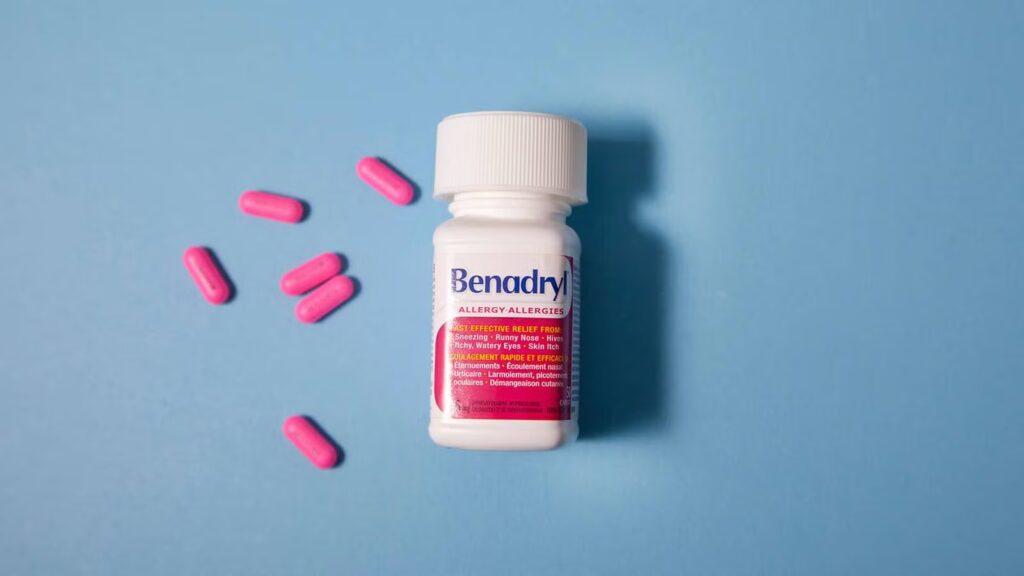How long does Benadryl stay in your system?
Insights from Live Free Recovery Services in New Hampshire
Home > Detection Times > How long does Benadryl stay in your system?
TL;DR – Benadryl (diphenhydramine) typically stays in your system for about 4 to 24 hours, depending on various factors like age, metabolism, organ function, and dosage.
Diphenhydramine (Benadryl) is a first-generation allergy medicine. It relieves symptoms from hay fever, hives, colds, and insect bites.
Invented in the 1940s[1], Benadryl is now one of the most trusted brands of antihistamines in the market.
Yet, it has more side effects than newer allergy medicines. Our health, metabolism, and age also affect the time it takes to flush Benadryl out of our bodies. Not following dosages could be dangerous!
Because of this, it’s vital to delve into some questions: How long does Benadryl stay in your system? Do we trust this household brand too much?
Let’s find out!
The Pharmacokinetics of Diphenhydramine (Benadryl)
Histamine is a chemical that our immune system releases when there’s an invader in our bodies. While it helps fight foreign invaders, it also causes allergy symptoms like runny nose or watery eyes.

Antihistamines work by blocking histamine from connecting to H1 receptors within our body.
The whole process of absorption and distribution starts within three hours of ingestion.
Metabolism of Diphenhydramine by the Liver
After digestion in the stomach, diphenhydramine first goes to the liver. The liver metabolizes 50 to 60% of the medication and circulates it throughout your body. It then works to stop your allergy symptoms.
The whole process takes 24 to 48 hours to finish. However, during this time, diphenhydramine may cause liver damage depending on the dose.
Moreover, as Benadryl spreads, it also passes through the blood-brain barrier. This is notable because in doing so, it causes undesirable side effects, like drowsiness and memory loss.
Second-generation antihistamines, like Zyrtec and Claritin, don’t have the same side effects. This is because they don’t pass through the blood-brain barrier!
Excretion of Diphenhydramine and Its Metabolites Through the Kidneys
We’ve said that the liver only metabolizes 50 to 60% of Benadryl. Did you wonder what happens to the remaining 40 to 50%?
The short answer is it gets brought to the kidney, which filters out most of the remaining medicine.
Your kidney sends useful substances back to the liver. Meaning, another 50 to 60% of the returned Benadryl gets metabolized.
This process repeats until all the diphenhydramine gets used up. After this, the metabolites and any diphenhydramine that the kidney missed excretes into the urine.

The Average Timeline for Diphenhydramine (Benadryl) In Drug Tests
How long does it take for Benadryl to completely flush out of your system? These are the average timelines based on the type of blood test.
- Urine Tests: Diphenhydramine stays within urine for two to four days after ingestion. It can even give false positives during opioid drug tests.
- Blood Tests: Doctors can detect Benadryl in your blood for one to two days after taking the medication.
- Saliva Tests: The average timeline for diphenhydramine in saliva is three to four days.
- Hair Tests: A study showed that Benadryl can stay in hair follicles for up to seven weeks!
| Test Type | Detection Period | Notes |
|---|---|---|
| Urine Tests | 2 to 4 days | Can give false positives for opioids |
| Blood Tests | 1 to 2 days | |
| Saliva Tests | 3 to 4 days | |
| Hair Tests | Up to 7 weeks |
Factors That Affect the Detection Window of Diphenhydramine
How long Benadryl stays in your system gets affected by a lot of factors! Understanding what these are will help you stay safe when consuming diphenhydramine.
Here are some reasons why diphenhydramine may stay in your body.
1. Age
Benadryl takes longer to metabolize the older we get.
It only takes 4 to 7 hours for children’s bodies to halve the total amount of diphenhydramine in their system. Meanwhile, adults would take 7 to 12 hours.
For the elderly, it could take up to 18 hours.

2. Dosage and Frequency
Drug concentration, volume, and intake frequency all affect the detection window of diphenhydramine.
The more Benadryl you drink, the longer it’ll take your body to wash everything out.
To add, the concentration of diphenhydramine in your body goes above normal levels when you take the next dose. That’s because the kidney filters out any unused diphenhydramine from the previous dose, and sends it back to the liver.
3. Drug-Drug and Drug-Food Interactions
The food we eat and the medicine we take may react with diphenhydramine in our bodies. Depending on this reaction, the absorption of the drug could either hasten or slow down.
For instance, you shouldn’t take alcohol and Benadryl together. This is because both Benadryl and alcohol are central nervous system depressants. Drinking alcohol may raise the sedative effects of Benadryl.
Diphenhydramine can also interact with other medications that you take. They could increase, decrease, or prolong the absorption rate of Benadryl.
Avoid taking antidepressants, cough medicine, benzodiazepines, opioids, and sedatives like sleeping pills!
4. Health and Metabolism
Blood circulates medicine through our body. The distribution of Benadryl takes longer for people who are ill. This is because they might have reduced blood flow.
Other factors within our body, like stomach acidity, physical activity, and stress levels, all come into play.
Interestingly, regular exercise accelerates drug absorption from intramuscular sites. It also increases your respiration rate and blood flow. Meaning, exercise can make you feel the side effects of Benadryl faster.
When this happens, diphenhydramine levels in drug tests appear higher compared with tests from people who don’t exercise.

5. Sex
According to UC Berkeley, 90% of women experience worse side effects from drinking medication than men.
Moreover, the study found women taking the same dosage as men have higher concentrations of the drug in their system. The drug stayed for longer as well.
Limitations for Diphenhydramine Detection In Drug Tests
Several factors may hinder diphenhydramine detection in drug tests.
Medical professionals should test the sample within four minutes of collection. The sample’s temperature should also stay within the right temperature.
It may be hard to control the food and medication consumed by patients. These affect the detection of diphenhydramine in drug tests.

Potential Side Effects and Risks of Using Diphenhydramine (Benadryl)
Because Benadryl is a first-generation antihistamine, it passes through the blood-brain barrier. Side effects include the following:
- Drowsiness, dizziness, and nausea
- Loss of appetite and constipation
- Headache
- Muscle weakness
- Dry nose and throat
- Vision problems
- Short-term memory loss
- Difficulty with urination
The FDA warns that prolonged exposure to diphenhydramine causes heart problems and seizures. It can result in hallucinations and be fatal as well.
Researchers even discovered that taking Benadryl increased dementia and Alzheimer’s disease in some patients.
The Risk of Excessive Use of Diphenhydramine
Benadryl can cause impaired learning in children. It sedates kids, making them feel confused. It affects their school performance and degrades their motor skills.
Diphenhydramine also has a hand in hindering driving skills by slowing your reaction time. The CDC says that drowsy driving caused 81,000 crashes and 800 deaths in 2017.
Another cause for concern is people that use Benadryl to help with sleep.
If you or your child has difficulty sleeping, using Benadryl to fall asleep is a terrible decision. All it does is make you drowsy. It doesn’t solve the underlying issue!
Interactions with Other Medications and Substances
These are some medicines to avoid if you’re taking Benadryl:

Safe Use and Discontinuation of Diphenhydramine (Benadryl)
Safely using diphenhydramine is easy. All you have to do is follow dosage guidelines!
For adults with mild allergy symptoms, 25 mg every 4 to 6 hours is all you need. You can take the same dose every 2 to 4 hours if you’re experiencing severe symptoms.
Children aged 2 to 5 should only receive 37.5 mg per day at most. Meanwhile, those ages 6 to 11 may do with 150 m per day max.
Make sure to research the correct dosage before you take Benadryl.
Discontinuing Diphenhydramine Usage
According to the NHS, you can’t take diphenhydramine for longer than two weeks. If you do, you might start to become dependent on the medication. It may also stop working to relieve allergy symptoms.
Diphenhydramine withdrawal is severe and takes 7 to 14 days to finish. If you’re dependent on the drug, abrupt stopping of the medication can turn into a medical emergency.
This is why it’s imperative to consult with a healthcare professional before you stop the use of Benadryl.
Moreover, you should familiarize yourself with potential withdrawal symptoms. Call your doctor if you’re experiencing the following:
- Nausea
- Vomiting
- Severe headaches and body pain
- Sweating and tremors
- Fever and palpitations
- Sleeplessness
- Seizures
- Hallucinations
- Anxiety attacks
Safer Alternatives to Diphenhydramine
We understand that Benadryl is a name brand that many people trust. Yet, second-generation antihistamines have fewer side effects.
Loratadine, cetirizine, and fexofenadine are less likely to sedate a person. They’re also safer for kids and elderly people.

Conclusion
How long does Benadryl stay in your system?
The quick answer is it takes our body 24 to 48 hours to process the substance. However, it can show up in urine tests up to four days after ingestion.
You should understand the timeline of diphenhydramine in your system so you know when to take the next dosage. That’s because taking too much causes nasty side effects.
If you must take Benadryl, focus on safe and responsible use. Always get personalized guidance from a healthcare professional!
Did this article answer your questions?
"*" indicates required fields
Take the First Step Towards a Brighter Tomorrow
At Live Free Recovery, we’re committed to walking alongside you on every step of your journey. Our compassionate team is here to provide the guidance and support you need to overcome addiction and reclaim your life. Don’t wait—reach out today to speak with someone who truly understands your struggles and can help you take that important first step toward healing and a fresh start.
Your path to recovery starts here.
